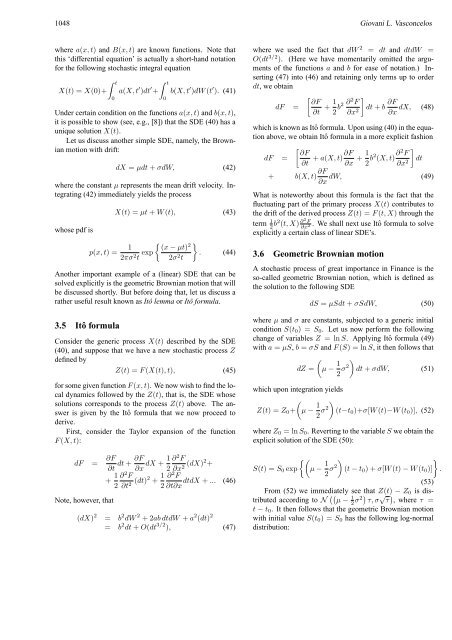A Guided Walk Down Wall Street: An Introduction to Econophysics
A Guided Walk Down Wall Street: An Introduction to Econophysics
A Guided Walk Down Wall Street: An Introduction to Econophysics
Create successful ePaper yourself
Turn your PDF publications into a flip-book with our unique Google optimized e-Paper software.
1048 Giovani L. Vasconcelos<br />
where a(x, t) and B(x, t) are known functions. Note that<br />
this ‘differential equation’ is actually a short-hand notation<br />
for the following s<strong>to</strong>chastic integral equation<br />
X(t) = X(0)+<br />
∫ t<br />
0<br />
a(X, t ′ )dt ′ +<br />
∫ t<br />
0<br />
b(X, t ′ )dW (t ′ ). (41)<br />
Under certain condition on the functions a(x, t) and b(x, t),<br />
it is possible <strong>to</strong> show (see, e.g., [8]) that the SDE (40) has a<br />
unique solution X(t).<br />
Let us discuss another simple SDE, namely, the Brownian<br />
motion with drift:<br />
dX = µdt + σdW, (42)<br />
where the constant µ represents the mean drift velocity. Integrating<br />
(42) immediately yields the process<br />
whose pdf is<br />
X(t) = µt + W (t), (43)<br />
p(x, t) = 1 { } (x − µt)<br />
2<br />
2πσ 2 t exp 2σ 2 . (44)<br />
t<br />
<strong>An</strong>other important example of a (linear) SDE that can be<br />
solved explicitly is the geometric Brownian motion that will<br />
be discussed shortly. But before doing that, let us discuss a<br />
rather useful result known as Itô lemma or Itô formula.<br />
3.5 Itô formula<br />
Consider the generic process X(t) described by the SDE<br />
(40), and suppose that we have a new s<strong>to</strong>chastic process Z<br />
defined by<br />
Z(t) = F (X(t), t), (45)<br />
for some given function F (x, t). We now wish <strong>to</strong> find the local<br />
dynamics followed by the Z(t), that is, the SDE whose<br />
solutions corresponds <strong>to</strong> the process Z(t) above. The answer<br />
is given by the Itô formula that we now proceed <strong>to</strong><br />
derive.<br />
First, consider the Taylor expansion of the function<br />
F (X, t):<br />
dF = ∂F ∂F<br />
dt +<br />
∂t ∂x dX + 1 ∂ 2 F<br />
2 ∂x 2 (dX)2 +<br />
+ 1 ∂ 2 F<br />
2 ∂t 2 (dt)2 + 1 ∂ 2 F<br />
dtdX + ... (46)<br />
2 ∂t∂x<br />
Note, however, that<br />
(dX) 2 = b 2 dW 2 + 2ab dtdW + a 2 (dt) 2<br />
= b 2 dt + O(dt 3/2 ), (47)<br />
where we used the fact that dW 2 = dt and dtdW =<br />
O(dt 3/2 ). (Here we have momentarily omitted the arguments<br />
of the functions a and b for ease of notation.) Inserting<br />
(47) in<strong>to</strong> (46) and retaining only terms up <strong>to</strong> order<br />
dt, we obtain<br />
[ ∂F<br />
dF =<br />
∂t + 1 ]<br />
2 b2 ∂2 F<br />
∂x 2 dt + b ∂F dX, (48)<br />
∂x<br />
which is known as Itô formula. Upon using (40) in the equation<br />
above, we obtain Itô formula in a more explicit fashion<br />
[ ∂F<br />
dF = + a(X, t)∂F<br />
∂t ∂x + 1 ]<br />
2 b2 (X, t) ∂2 F<br />
∂x 2 dt<br />
+ b(X, t) ∂F dW, (49)<br />
∂x<br />
What is noteworthy about this formula is the fact that the<br />
fluctuating part of the primary process X(t) contributes <strong>to</strong><br />
the drift of the derived process Z(t) = F (t, X) through the<br />
term 1 2 b2 (t, X) ∂2 F<br />
∂x<br />
. We shall next use Itô formula <strong>to</strong> solve<br />
2<br />
explicitly a certain class of linear SDE’s.<br />
3.6 Geometric Brownian motion<br />
A s<strong>to</strong>chastic process of great importance in Finance is the<br />
so-called geometric Brownian notion, which is defined as<br />
the solution <strong>to</strong> the following SDE<br />
dS = µSdt + σSdW, (50)<br />
where µ and σ are constants, subjected <strong>to</strong> a generic initial<br />
condition S(t 0 ) = S 0 . Let us now perform the following<br />
change of variables Z = ln S. Applying Itô formula (49)<br />
with a = µS, b = σS and F (S) = ln S, it then follows that<br />
dZ =<br />
(µ − 1 )<br />
2 σ2 dt + σdW, (51)<br />
which upon integration yields<br />
Z(t) = Z 0 +<br />
(µ − 1 )<br />
2 σ2 (t−t 0 )+σ[W (t)−W (t 0 )], (52)<br />
where Z 0 = ln S 0 . Reverting <strong>to</strong> the variable S we obtain the<br />
explicit solution of the SDE (50):<br />
S(t) = S 0 exp<br />
{(µ − 1 )<br />
}<br />
2 σ2 (t − t 0 ) + σ[W (t) − W (t 0 )] .<br />
(53)<br />
From (52) we immediately see that Z(t) − Z 0 is distributed<br />
according <strong>to</strong> N (( µ − 1 2 σ2) τ, σ √ τ ) , where τ =<br />
t − t 0 . It then follows that the geometric Brownian motion<br />
with initial value S(t 0 ) = S 0 has the following log-normal<br />
distribution:
















